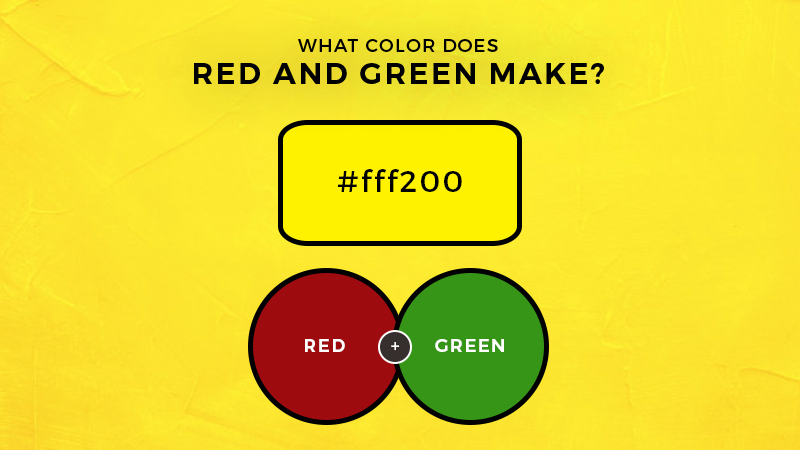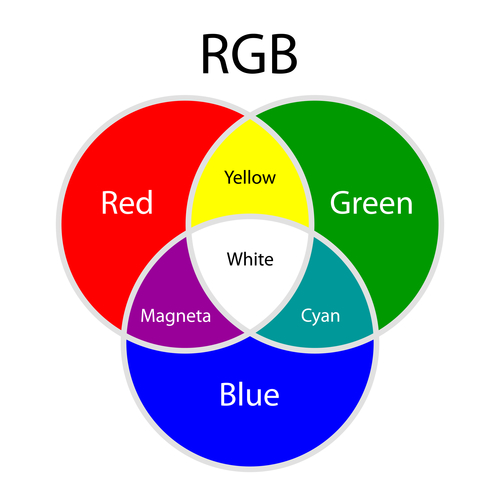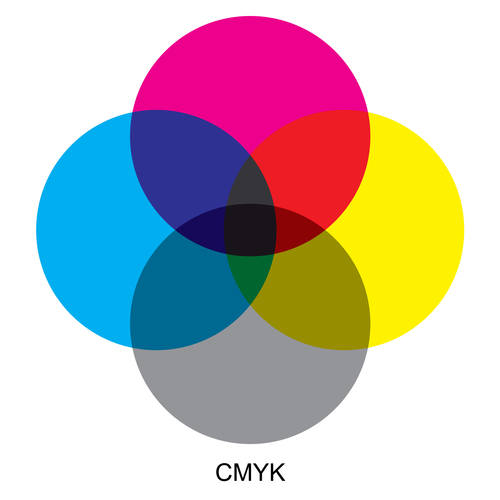What Color Do Red And Green Make?
Have you ever asked yourself, “What color do red and green make when mixed together?”
When it comes to mixing colors, it may not be as straightforward as what you see on the color wheel. Using different methods of color mixing, such as overlapping colored lights versus combining pigment, the resulting colors are extremely different.
If you’ve ever wondered what color red and green make, we’ll explore the answer in the two different color combining methods.
What Color Do Red and Green Make?
Essentially, there are two methods for mixing color: Additive and Subtractive. Depending on the method you use, you may get a different color than you were originally expecting.
Additive Mixing
Additive mixing is not the traditional method that we think of when mixing colors. However, in today’s technology-driven society, it’s a pretty common method that we see almost daily without realizing it.
With additive mixing, you use varying combinations of spectral light to mix colors. This method is often used in media, most commonly in how colors projected on television screens and computer monitors are produced.
There are two ways that colors can be combined using additive mixing:
- Using two colors, the electron guns in television and computer monitors fire two different colors rapidly, causing our eyes to see them as they morph together into a completely different color.
- Two or more solid spectral-colored lights are combined by being placed closely together, causing our eyes to optically mix the two into a different color.
RGB Color Wheel
When it comes to light or screen color mixing, this method uses the RGB color wheel. In this form, red, blue, and green are the primary colors of light used on the wheel. The secondary colors are formed by the mixture of two primary colors, resulting in cyan, magenta, and yellow.
Looking at their placement on the RGB color wheel, when red and green are mixed together, they make the color yellow.
The RGB color wheel for producing colors using light spectrums is almost the opposite of the CMYK color wheel used traditionally for mixing colors in art and print processing, a method called subtractive mixing.
Subtractive Mixing
Subtractive mixing is a more intuitive method of mixing color, one that we often associate in the traditional sense of color mixing. Subtractive colors are seen when pigments within an object or liquid absorb white light while reflecting the rest of the pigments that make up its color.
For example, the color red reflects all the wavelengths of white light except for the red pigments, which is how our minds perceive the color.
This is the most common method of color mixing, as we see it everywhere in regular objects. It’s also used in the process of print production.
Unlike additive mixing, the subtractive mixing method uses the CMYK color wheel primarily used in art and print processing.
CMYK Color Wheel
Unlike the RGB wheel used for combining colors across the light spectrum, the primary colors for the CMYK color wheel consist of cyan, magenta, and yellow. In art production, these colors often correlate to the traditional primary colors of the art color wheel (blue, red, and yellow).
However, the secondary colors are the same as the primary colors on the RGB wheel (red, blue, and green).
In print processing, color combinations are produced by overlapping layers of the primary CMY colors in varying percentages of transparency. Once the colors are overlapped, light is transmitted through the ink and reflects off of the surface below, called the substrate.
The CMY ink is applied as halftone dots and subtracts the inverse percentages of RBG from the reflected light so that our eyes perceive the intended color.
Green and Red Make Yellow Video Demo
Complementing Colors
Complementing colors refer to two colors that sit across from each other on their prospective color wheels. The two opposite colors will often turn gray when mixed together.
In the CMYK model, red and green are presented as complementing colors. However, when you combine red and green, they can vary in shades of brown to gray depending on the particular shades you are using.
For example, blue-green and red may combine pigments that appear as a gray color, since it is using mostly cool tones. However, a saccharine green and red mix to make more of a brown color, due to the yellow pigments in the green contributing to warmer tones in the combined color mixture.
As you can see, there are a couple of different answers to your question, “What do red and green make when mixed together?” Depending on the method you use to mix the colors, you may see a lovely yellow glow on your screen or a shade of brown or gray in your print.
When deciding which colors to use, knowing the media or method in which you plan to mix them will help you make the best decision for your intended outcome.
Play around with different colored lights and paint by mixing red and green together to see the results for yourself. Now that you know what color does red and green make you can start creating stuff and sharing it with your friends.
Read Latest Posts

Hi, I'm Anthony Tran! Welcome to my site. I live in Arizona and am obsessed with all things related to building an Online Business and working from home. Learn about my journey here.
Follow Online





